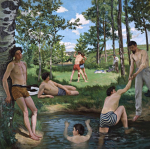 Peter Schjeldahl at The New Yorker:
Peter Schjeldahl at The New Yorker:
“Frédéric Bazille and the Birth of Impressionism,” at the National Gallery, in Washington, D.C., is a great show, which surprised me. Bazille was not—or was not yet—a great artist when he died, in 1870, at the age of twenty-eight, in the Franco-Prussian War. His some seventy-five works in the show, notably scenes of ordinary people in outdoor settings, tantalize like an orchestra tuning up for a concert that is abruptly cancelled. A yearningly ambitious provincial, from Languedoc, Bazille lucked into the big-bang commencement of Parisian modernism, signalled by the stunning novelty of Édouard Manet’s “Déjeuner sur l’Herbe,” in 1863. Bazille was friends with Monet and Renoir, sharing studios with them on the Left Bank and in Montmartre, and he knew everybody else in art worth knowing. You can feel the verve of the happy few in a sprightly painting by Bazille, dated 1869-70, which shows him and five of his colleagues socializing in a daylight-suffused studio. One of them, Manet, painted in the tall figure of Bazille. (At six feet two, Bazille towered in his milieu—and likely in enemy gun sights, when, on his first day of combat, he charged, and was shot dead, in the colorful uniform of a Zouave.) But to call him one of the proto-Impressionists doesn’t seem quite right. Rather, he reflected each of them, by turns, as his real but insecure talent veered back and forth, and this way and that, in their stronger gravitational fields.
What makes the show great is the point of view that it affords not only on the birth of Impressionism but also on the general dawning of modernist sentiments and sensibilities. Bazille serves as our stand-in throughout a crisply dramatic installation, by the National Gallery curator Kimberly A. Jones, which incorporates apposite paintings by, among others, Corot, Courbet, Manet, Cézanne, Monet, Renoir, Sisley, Fantin-Latour, and Morisot. Bazille’s parallels and responses to those artists amount to a critical index of a moment when the course of art was feverishly contested and its future was trackless.
more here.
